While top-notch design skills are essential to running a successful interior design business, many other factors can also impact whether a potential client decides to move forward. One of these factors is the interior design proposal.
When multiple designers are bidding for the business of a single client—which is often the case in our competitive industry—the strength of your proposal has the power to make or break a deal, believe it or not.
That is why it is crucial to invest the time and effort into ensuring your proposals are well-written, on-brand, and well-presented.
Not only does a great proposal showcase your creativity and expertise, but it also sets the groundwork for clear communication and effective project management, all of which are key to a successful project. Your proposal also acts as a strategic tool to articulate your vision and ideas, demonstrate your professionalism, and ultimately convince potential clients that you are the best fit for their project.
In this guide, we’ll walk through the essential steps of how to put together an interior design proposal, explain why it’s so important, and outline what to include. And because we totally understand the importance of seeing examples, we’ve spotlighted a few helpful interior design proposal templates to get you started.
Table of Contents
How to write an interior design proposal
The interior design proposal usually comes into play after you’ve had an initial consultation with a potential client, seen their space, and assessed their needs. Once you’ve determined whether the project and client are a good mutual fit, and moving forward makes sense, it’s time to create a proposal outlining how you foresee the project unfolding, in terms of scope, design concept, communication, timeline, and budget.
You’ll send this proposal to your potential client following the consultation in order to encapsulate what was discussed during that initial meeting, provide a quote, and give the client a clear direction of what’s involved and next steps.
So how do you write an interior design proposal? For starters, you don’t want your proposal to feel solely like an informational document. It’s actually also a major sales asset. So, in addition to covering all the project logistics, your proposal should create a sense of magic and excitement for the client. It should also feel true to your brand, style, and design philosophy.
In order to accomplish this, you should consider the following 4 factors:
1. Presentation
The visual presentation of your proposal is your first chance to impress and captivate your potential client. Even if your website and portfolio look amazing, and the design consultation went great, a shoddily designed proposal will instantly turn off your potential clients. The design and aesthetic of your proposal will also directly reflect the work your client can expect from you. So you need to be careful as you format your document, making sure it’s beautiful and true to your aesthetic and brand. Include your logo, use your brand colors, and apply the same font styles as you do in other marketing materials in order to strengthen brand recognition and give your proposal a professional sheen.
A few things to keep in mind: Use a consistent color palette, typography, and layout that reflects both your brand and the client’s tastes. This could mean incorporating elements from the clients space into the proposal design, such as color schemes, textures, or motifs.
2. Storytelling
Your proposal should be compelling and relatable, and storytelling is a great way to pull this off. Put yourself in your client’s position. Think about the challenge(s) they are currently facing that caused them to reach out to you. Then think about how their life will change as a result of your work together. Paint a vivid picture of the future comfort, functionality, and aesthetic the project will achieve. Also, highlight the emotional benefits, such as comfort, pride, or happiness that the the new design will bring. For example, if you’re designing a family room, talk about the warm, inviting atmosphere that will be ideal for creating lasting memories.
Let the story of the transformation shine through in your proposal. Remember: your proposal is an opportunity to stir up your client’s optimism and enthusiasm for the project—and for working with you!
3. Tone
Your tone should be reflective of your personality and brand. Think of your proposal as a letter to your client. Write in a conversational tone, as if you are speaking directly to them, and ensure your tone is consistent with the interactions you’ve had with the client so far. The tone in your proposal will give your client a taste of what to expect in terms of future communications with you and your team, so we recommend keeping it warm, friendly, and inviting.
The best way to get started on writing your proposal is to find a template that reflects your style (see 7 curated options below!). You can then customize the template to fit the needs of your unique brand, the particular client, and project, and email the finished interior design proposal as a PDF after the consultation.
4. Personalization
While you absolutely should have a proposal template in your arsenal to streamline the process, it’s essential to take time to personalize each one. A personalized proposal will ensure yours stands out and resonates with your ideal clients. This involves more than just adding a client’s name to the document. It’s about tailoring the content to reflect their specific needs, preferences, and the unique aspects of their project.
Why it’s important to send a proposal or quote
Sending a detailed proposal or quote is crucial in the interior design industry for several reasons
1. Professionalism
Following up after a consultation with a killer proposal reflects your professionalism and commitment to the project. A detailed proposal shows that you are serious about your business and have what it takes to meet the client’s needs.
2. Clarity and setting expectations
A proposal clarifies all aspects of the project for both parties. It details the scope of work, budget, timeline, and your design vision, which helps prevent misunderstandings and sets clear expectations from the outset.
3. Competitive edge
A well-prepared proposal can give you a competitive edge in securing new contracts. It demonstrates your capability to not only design but also manage a project efficiently, which is crucial for winning over clients.
What to include in an interior design proposal
All interior design proposals are slightly different, but here are the key components you should always be sure to include.
1. Cover letter
To make your proposal feel friendly and personal, we recommend starting with a short cover letter, or welcome note. In addition to welcoming the client and expressing your enthusiasm for their project, we recommend letting them know what to expect in the proposal and instructions on next steps.
2. About the firm
Even though the client may have already reviewed this info on your website, it’s still a good idea to briefly reiterate who you are and what you bring to the table.
3. Detailed project description
Provide a detailed description of the project, including the design requirements and the objectives that the design aims to achieve. Also include details about the client here, including their stated preferences, constraints, budget, and anything else discussed during the consultation.
4. Scope of services
Clearly state the services you will provide. This could range from conceptual development and space planning to project management and post-installation services to full-service.
5. Design process
Provide an overview of your design process and the steps your client can expect through project completion.
6. Project fees
Your budget should be as detailed as possible, covering all costs associated with the project. Your price list should include your design fees, anticipated costs for materials, labor, and any other expenses.
7. Project timeline
Detail the expected timeline for the project, including each phase of the design and implementation process. Include key milestones and expected completion dates.
8. Benefits of working with your firm
Wrap up your proposal with a case for the benefits of working with your firm. This is also a great opportunity to include a portfolio project or two, especially if you have a previous example of similar scope and style to the proposed project. This enables the client to envision how their own project might turn out, and helps ramp up both your credibility and their excitement.
9. Terms
Outline the terms and conditions related to the proposal, including payment terms, project deliverables, and any warranties or guarantees.
By addressing the above elements, your interior design proposal will effectively communicate all necessary information, ensuring that both you and your client have a clear understanding of the project scope, requirements, and expectations. This thoroughness will significantly increase your chances of securing the project.
How to create an interior design proposal in DesignFiles
Creating an interior design proposal in DesignFiles is fast, polished, and fully customizable. Start by using the moodboard software to lay out your design vision. Each slide can be tailored using brandable templates where your logo, color palette, and fonts are automatically applied. This way, every client-facing document you create feels consistent with your brand. DesignFiles also provides a detailed video tutorial on creating a design presentation, which translates perfectly to proposal creation, giving you clear guidance step by step.
You can easily add key proposal information (like project scope, estimated costs, or design concepts) across different moodboard slides. Once your proposal is complete, export the entire presentation as a single PDF to share with clients via email or your client portal. And if you’re ready to move forward with the project, there’s no need to leave the platform. Use DesignFiles’ integrated contract software to get your proposal e-signed directly within the system.
Here’s a tutorial video with the step-by-step process for creating a presentation or proposal with our moodboard editor:
7 interior design proposal templates
Ready to hit the ground running and pull together a winning interior design proposal?
Consider using one of these interior design proposal templates. Below we’ve got both free and paid options to choose from.
1. Honeybook Proposal Template from Dakota Design Co
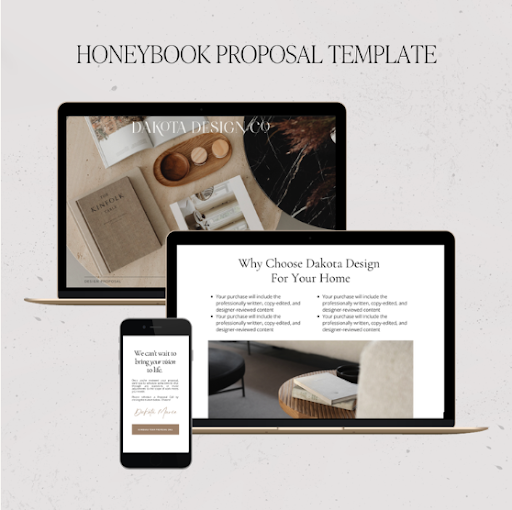
Price: $350
2. Business Proposal Template from Canva
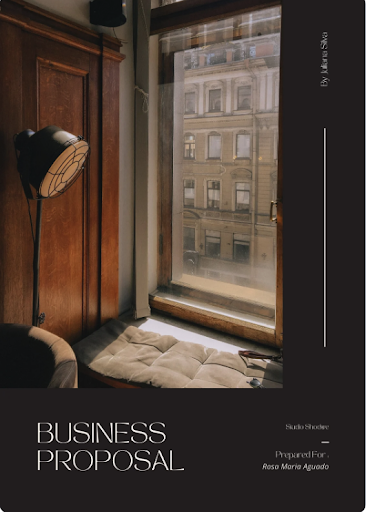
Price: Free
This free business proposal template from Canva is easy to customize and has an inviting minimalist style. It includes 4 pages, but you can easily add additional pages and customize the headings and photos to fit your brand.
3. Interior Design Proposal Template from Etsy
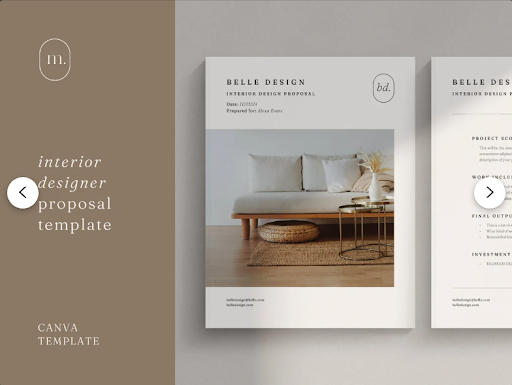
Price: $4.40
This elegant interior design proposal template from Etsy is budget-friendly with a crisp, clean aesthetic. Once you’ve downloaded the template, you can use Canva to customize and make any edits or adjustments. If the reviews are anything to go by, it’s a great investment!
4. The Fee Proposal Template by the Little Design Corner
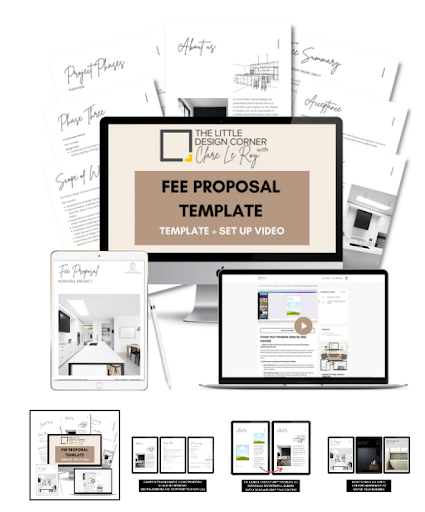
Price: $65
The Little Design Corner with Clare Le Roy is an online shop full of courses and resources for interior designers. Her shop features this Fee Proposal Template, which includes 12 customizable pages, a fully written sample proposal for inspiration and guidance, and according to the website, “high-converting copy, which has been proven to convert over 90% of potential clients into lucrative, paid projects.”
5. The Clara Design Proposal from IDCO
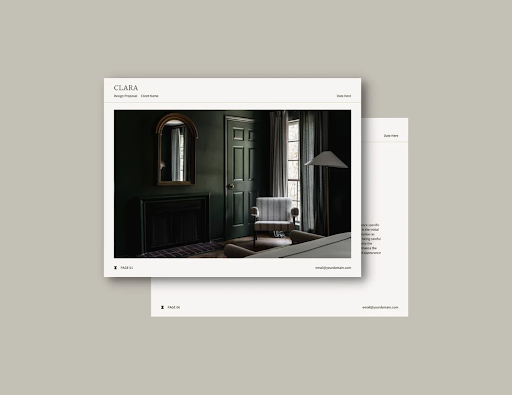
Price: $375
This template option from IDCO, a popular resource for business templates for interior designers is just one of many available on their site for the same price. The proposal template includes all the components you need, and can be integrated with your brand colors, fonts, logo, and portfolio imagery. Take a look and find one that best fits your brand and needs.
6. Interior Design Proposal Template from PandaDoc
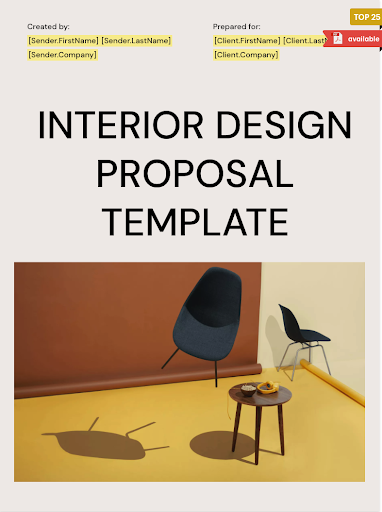
Price: Free
Offered by software company Panda Doc, this template is a solid free option, but you would need to heavily customize it in order to add your own style, personality, and branding.
7. Arlo Interior Design Proposal Template from Sonderpath Studio
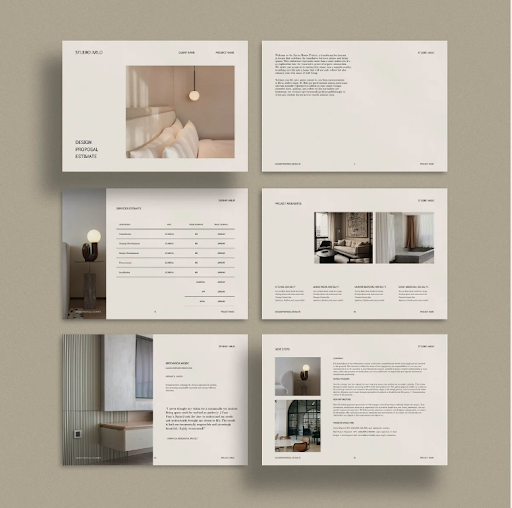
Price: £22
This offering from Sonderpath Studio, a UK-based template resource for interior designers, is elegant and comprehensive. The price includes Canva and Adobe InDesign template links, a Help Guide, and a selection of royalty-free images to use in your proposal.
Conclusion
As you can see, it’s essential to crush it when it comes to crafting your interior design proposal. When you recognize that the proposal serves not just as a bid for a project, but as an extension of the essence of your design philosophy and business acumen, you’ll be on the path toward success.
Remember: the interior design proposal is a reflection of your brand’s identity and promise. By meticulously aligning the design and tone of your proposal with your brand, you create a sense of consistency and reliability that will resonate with the right clients. This brand consistency will not only help in reinforcing your aesthetic but also builds trust with clients, enabling them to see the tangible manifestation of your design ethos right from the getgo.
By focusing on personalization, storytelling, and brand alignment, your proposal will not only capture the imagination of your potential clients, but also lay a strong foundation for successful project execution and client satisfaction.
With the right approach, your proposals will do more than secure projects—they will create lasting impressions and foster enduring relationships.
Ready to streamline your interior design projects? Learn more about DesignFiles.


![Average Interior Designer Salaries in 2025 [Plus How to Earn More!]](https://blog.designfiles.co/wp-content/uploads/2022/10/interior-designer-income-salary-768x439.jpeg)